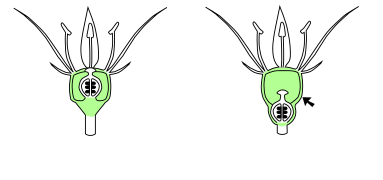Flower axis

a androeceum , g pistil
red ovary; I above (hypogyn), II semi-below (epihypogyn) (perigyn), III below (epigyn) (gynoeceal hypanthium)
In botany, the section of the stem axis that bears the organs of the flower ( sepals , petals , ovaries, etc.) is called the flower axis , flower base or receptaculum (also thalamus or torus ) . It is the direct continuation of the flower stem . The flower axis can be shaped differently.
If the flower base is cup-shaped or tubular, it is called a hypanthium . Different variants are then possible, with an under- (epigynous), semi-under- (epihypogyn) or middle (perigyn) ovary or as a mixture of middle and lower ovary (epihypoperigyn). The ovary below can also be fused below the hypanthium (epiperigyn).
The internodes of the flower axis are often compressed to a flower base on which the flower organs sit. This can be beaded, flat, disc-shaped, tail-shaped, jug-shaped (e.g. rose ) or conically arched (e.g. strawberries ) or also hollow. When the strawberry ripens, the bottom of the flower forms a juicy, fleshy pseudo-berry .
The flower base can also be formed with an internode , which lifts the ovary , either gynophor , androgynophor or flower-bearing (anthophor). A stalked (stipitater) ovary is not the same, here a narrowed basal part of the ovary forms a stalk.
A special shape is the columnar shape of the flower base as a stamen carrier (androphoric), here the stamens are above and the sepals and petals below the hypanthium. The ovary can be arranged differently here. The staminophore , which occurs in the eucalyptus and the myrtle family , forms a special form , here a special band of tissue is formed on the hypanthium, which acts as a stamen carrier.
In the case of the daisy flowers of the daisy family , it is the flower base, the flower bed (Clinanthium, Phoranthium) of the individual flowers, which together form the flower basket (Calathium, Anthodium). In the fruit associations of figs hollow, fleshy, almost completely closed flowers bottom forms a Sykonium (Hypanthodium or flower cake) in which the flowers are, the bottom is more or less flat, then formed a Coenanthium as in the Dorstenia .
literature
- D. v. Denffer , H. Ziegler , F. Ehrendorfer , A. Bresinsky : Strasburger - textbook of botany for universities. 32nd edition. G. Fischer Verlag, Stuttgart / New York 1983, ISBN 3-437-20295-2 .
- Herder Lexicon of Biology. Spectrum academ. Verlag, 1994, ISBN 3-86025-156-2 .
- W. Rothmaler : Excursion flora. Volume 2: Vascular Plants. People and Knowledge, Berlin 1983.
- Michael G. Simpson: Plant Systematics. Academic Press, 2006, ISBN 978-0-12-644460-5 .
- Peer Schilperoord: Plasticity of the flower base and the ovary - underdevelopment. In: Elements of Science. 99, 2013, pp. 21–36, online (PDF; 2.72 MB), at urpflanze.ch, accessed on June 7, 2017.
Web links
Individual evidence
- ^ Meyers Konversations-Lexikon . 3rd edition, 3rd volume, 1874, p. 368, limited preview in the Google book search.






